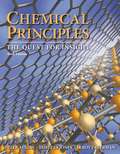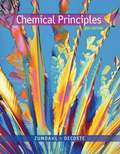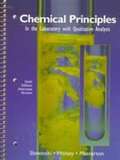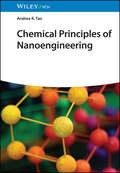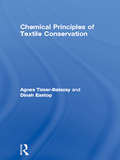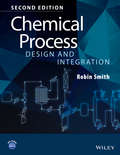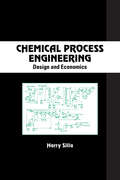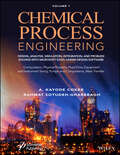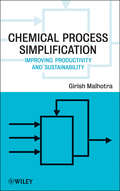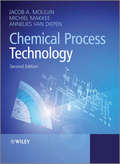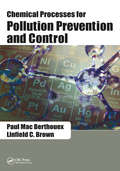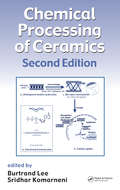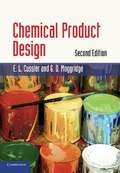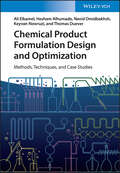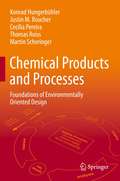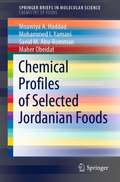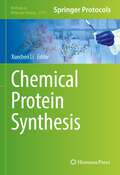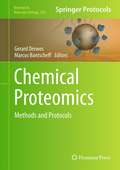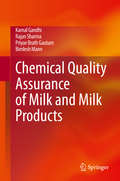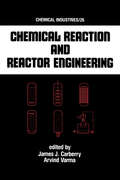- Table View
- List View
Chemical Principles: The Quest for Insight (6th Edition)
by Peter Atkins Loretta Jones Leroy LavermanWritten for calculus-inclusive general chemistry courses, Chemical Principles helps students develop chemical insight by showing the connections between fundamental chemical ideas and their applications. Unlike other texts, it begins with a detailed picture of the atom then builds toward chemistry's frontier, continually demonstrating how to solve problems, think about nature and matter, and visualize chemical concepts as working chemists do. Flexibility in level is crucial, and is largely established through clearly labeling (separating in boxes) the calculus coverage in the text: Instructors have the option of whether to incorporate calculus in the coverage of topics. The multimedia integration of Chemical Principles is more deeply established than any other text for this course. Through the unique eBook, the comprehensive ChemPortal, Living Graph icons that connect the text to the Web, and a complete set of animations, students can take full advantage of the wealth of resources available to them to help them learn and gain a deeper understanding.
Chemical Principles (Eighth Edition)
by Steven S. Zumdahl Donald J. DecosteDevelop the qualitative, conceptual foundation you need to think like a chemist with CHEMICAL PRINCIPLES, 8e. Designed for students with solid mathematical preparation, this best-seller emphasizes models, everyday applications of chemistry, and a thoughtful, step-by-step problem-solving approach.
Chemical Principles in the Laboratory with Qualitative Analysis: Sixth Edition
by William L. Masterton Wayne C. Wolsey Emil J. SlowinskiThis alternate version of Slowinski, CHEMICAL PRINCIPLES IN THE LABORATORY, Sixth Edition contains most of the original experiments as well as a full qualitative analysis scheme for the common cations and anions, in order to provide students with an opportunity to experience more descriptive chemistry than is available in most laboratory programs.
Chemical Principles of Nanoengineering
by Andrea R. TaoChemical Principles of Nanoengineering Understand the chemical properties of nanomaterials with this thorough introduction Nanomaterials, which possess at least one dimension lower than 100 nanometers, are increasingly at the forefront of technological and chemical innovation. The properties of these uniquely minute materials give them distinctive applications across a huge range of industries and research fields. It is therefore critical that the next generation of engineers and materials scientists understand these materials, their chemical properties, and how they form bonds. Chemical Principles of Nanoengineering answers this need with a thorough, detailed introduction to nanomaterials and their underlying chemistry. It particularly emphasizes the connection between nanomaterial properties and chemical bonds, which in turn allows readers to understand how these properties change at different scales. The result is a critical resource for understanding these increasingly vital materials. Chemical Principles of Nanoengineering readers will also find: Step-by-step arrangement of material to facilitate learning in sequence and gradual, self-guided progress End-of-chapter problems and key concept definitions to reinforce learning Detailed coverage of important nanomaterials like quantum dots, carbon nanotubes, graphene, and more Chemical Principles of Nanoengineering is a must-have for advanced undergraduates and beginning graduate students in materials science, chemical engineering, chemistry, and related fields.
Chemical Principles of Textile Conservation (Butterworth-heinemann Series In Conservation And Museology)
by Dinah Eastop Agnes Timar-Balazsy'Chemical Principles of Textile Conservation' provides must-have knowledge for conservators who do not always have a scientific background. This vital book brings together from many sources the material science necessary to understand the properties, deterioration and investigation of textile artefacts. It also aids understanding of the chemical processes during various treatments, such as: cleaning; humidification; drying; disinfestation; disinfection; and the use of adhesives and consolidants in conservation of historical textiles. Textile conservators will now have ready access to the necessary knowledge to understand the chemistry of the objects they are asked to treat and to make informed decisions about how to preserve textiles. The combination of a chemist and a conservator provides the perfect authorial team. It ensures a unique dual function of the text which provides textile conservators with vital chemical knowledge and gives scientists an understanding of textile conservation necessary to direct their research. The many practical examples and case studies illustrate the utility of the relatively large chemical introduction and the essential chemical information which is included. The case studies, many illustrated in colour, range from the treatment of the Ghandis' clothes, high-altitude flying suits and a Mary Quant raincoat, to the Hungarian Coronation Mantle.
Chemical Process Design and Integration: Design And Integration
by Robin SmithWritten by a highly regarded author with industrial and academic experience, this new edition of an established bestselling book provides practical guidance for students, researchers, and those in chemical engineering. The book includes a new section on sustainable energy, with sections on carbon capture and sequestration, as a result of increasing environmental awareness; and a companion website that includes problems, worked solutions, and Excel spreadsheets to enable students to carry out complex calculations.
Chemical Process Engineering: Design And Economics (Chemical Industries Ser. #Vol. 96)
by Harry SillaThis illustrative reference presents a systematic approach to solving design problems by listing the needed equations, calculating degrees-of-freedom, developing calculation procedures to generate process specifications, and sizing equipment. Containing over thirty detailed examples of calculation procedures, the book tabulates numerous easy-to-fol
Chemical Process Engineering Volume 1: Design, Analysis, Simulation, Integration, and Problem Solving with Microsoft Excel-UniSim Software for Chemical Engineers Computation, Physical Property, Fluid Flow, Equipment and Instrument Sizing
by Rahmat Sotudeh-Gharebagh A. Kayode CokerCHEMICAL PROCESS ENGINEERING Written by two of the most prolific and respected chemical engineers in the world, this groundbreaking two-volume set is the “new standard” in the industry, offering engineers and students alike the most up-do-date, comprehensive, and state-of-the-art coverage of processes and best practices in the field today. This first new volume in a two-volume set explores and describes integrating new tools for engineering education and practice for better utilization of the existing knowledge on process design. Useful not only for students, professors, scientists and practitioners, especially process, chemical, mechanical and metallurgical engineers, it is also a valuable reference for other engineers, consultants, technicians and scientists concerned about various aspects of industrial design. The text can be considered as a complementary text to process design for senior and graduate students as well as a hands-on reference work or refresher for engineers at entry level. The contents of the book can also be taught in intensive workshops in the oil, gas, petrochemical, biochemical and process industries. The book provides a detailed description and hands-on experience on process design in chemical engineering, and it is an integrated text that focuses on practical design with new tools, such as Excel spreadsheets and UniSim simulation software. Written by two industry and university’s most trustworthy and well-known authors, this book is the new standard in chemical, biochemical, pharmaceutical, petrochemical and petroleum refining. Covering design, analysis, simulation, integration, and, perhaps most importantly, the practical application of Microsoft Excel-UniSim software, this is the most comprehensive and up-to-date coverage of all of the latest developments in the industry. It is a must-have for any engineer or student’s library.
The Chemical Process Industries Infrastructure: Function and Economics (Chemical Industries)
by Lames R. Couper O. Thomas Beasley W. Roy Penney"Covers global and domestic competition, marketing strategies, operating expenses, and environmental and safety regulations for chemical professionals at all levels. Contains up-to-date mergers and acquisitions of chemical companies."
Chemical Process Simplification
by Girish K. MalhotraWhile emphasizing conservation and sustainable strategies, this book provides steps to improve the manufacturing technologies used in creating products. By simplifying the chemistry, process development, manufacturing practices and processes, the book provides a structured approach to producing quality products with little waste, making the process not only efficient but environmentally friendly. Illustrated with case studies, this is an essential resource for chemical engineers, chemists, plant engineers, and operating personnel in any chemical related businesses.
Chemical Process Technology
by Jacob A. Moulijn Annelies E. van Diepen Michiel MakkeeWith a focus on actual industrial processes, e.g. the production of light alkenes, synthesis gas, fine chemicals, polyethene, it encourages the reader to think "out of the box" and invent and develop novel unit operations and processes. Reflecting today's emphasis on sustainability, this edition contains new coverage of biomass as an alternative to fossil fuels, and process intensification.The second edition includes:New chapters on Process Intensification and Processes for the Conversion of BiomassUpdated and expanded chapters throughout with 35% new material overallText boxes containing case studies and examples from various different industries, e.g. synthesis loop designs, Sasol I Plant, Kaminsky catalysts, production of Ibuprofen, click chemistry, ammonia synthesis, fluid catalytic crackingQuestions throughout to stimulate debate and keep students awake!Richly illustrated chapters with improved figures and flow diagramsChemical Process Technology, Second Edition is a comprehensive introduction, linking the fundamental theory and concepts to the applied nature of the subject. It will be invaluable to students of chemical engineering, biotechnology and industrial chemistry, as well as practising chemical engineers. From reviews of the first edition:"The authors have blended process technology, chemistry and thermodynamics in an elegant manner... Overall this is a welcome addition to books on chemical technology." - The Chemist"Impressively wide-ranging and comprehensive... an excellent textbook for students, with a combination of fundamental knowledge and technology." - Chemistry in Britain (now Chemistry World)
Chemical Processes for Pollution Prevention and Control
by Paul Mac Berthouex Linfield C. BrownThis book examines how chemistry, chemical processes, and transformations are used for pollution prevention and control. Pollution prevention reduces or eliminates pollution at the source, whereas pollution control involves destroying, reducing, or managing pollutants that cannot be eliminated at the source. Applications of environmental chemistry are further illustrated by nearly 150 figures, numerous example calculations, and several case studies designed to develop analytical and problem solving skills. The book presents a variety of practical applications and is unique in its integration of pollution prevention and control, as well as air, water, and solid waste management.
Chemical Processes with Participation of Biological and Related Compounds: Biophysical and Chemical Aspects of Porphyrins, Pigments, Drugs, Biodegradable Polymers and Nanofibers
by Tatyana N. Lomova Gennady E. ZaikovThe book is devoted to kinetics and thermodynamics of the processes with participation of some biological compounds and their synthetic analogues. Aspects of their acting as model enzymes, molecular receptors, photo sensitizers, pharmocophores, and biopharmaceutical compounds are under consideration. Quantitative characteristics of transfer of cati
Chemical Processing Handbook
by John J. McKettaWritten by more than 40 world renowned authorities in the field, this reference presents information on plant design, significant chemical reactions, and processing operations in industrial use - offering shortcut calculation methods wherever possible.
Chemical Processing of Ceramics
by Burtrand Lee Sridhar KomarneniMany believe that the silicon/information age is heading to the Age of Biology and that the next frontier in ceramics will most likely require molecular level or nanoscale control. What, then, is the role of ceramics in the age of biology? As we change from an energy-rich society to an energy-declining society, how can ceramic materials appease the
Chemical Product Design
by E. L. Cussler G. D. MoggridgeThe chemical industry is changing, going beyond commodity chemicals to a palette of higher value added products. This groundbreaking book, now revised and expanded, documents this change and shows how to meet the challenges implied. Presenting a four-step design process – needs, ideas, selection, manufacture – the authors supply readers with a simple design template that can be applied to a wide variety of products. Four new chapters on commodities, devices, molecules/drugs and microstructures show how this template can be applied to products including oxygen for emphysema patients, pharmaceuticals like taxol, dietary supplements like lutein, and beverages which are more satisfying. For different groups of products the authors supply both strategies for design and summaries of relevant science. Economic analysis is expanded, emphasizing the importance of speed-to-market, selling ideas to investors and an expectation of limited time in the market. Extra examples, homework problems and a solutions manual are available.
Chemical Product Formulation Design and Optimization: Methods, Techniques, and Case Studies
by Ali Elkamel Hesham Alhumade Navid Omidbakhsh Keyvan Nowruzi Thomas DueverChemical Product Formulation Design and Optimization Explore the cutting-edge in chemical product formulation and design In Chemical Product Formulation Design and Optimization: Methods, Techniques, and Case Studies, a team of renowned technologists and engineers delivers a practice guide to chemical product design. Offering real-world case studies for disinfectant formulation, the optimization of defined media, and the formulation of biocomposites, the book contains introduction to the current product design process. In addition to the background of related statistical techniques, readers will find: Clear illustrations, figures, and tables that improve understanding and retention of critical topics Thorough introductions to the mathematical principles of chemical product design A complete examination of intellectual property considerations in the chemical product design process Ideal for process and chemical engineers, Chemical Product Formulation Design and Optimization: Methods, Techniques, and Case Studies is a must-read resource for professionals in the pharmaceutical and cosmetics industry as well as chemical engineers working in the food, paint, and dye industries who seek a one-stop resource that includes the latest advances in chemical product formulation.
Chemical Products and Processes: Foundations of Environmentally Oriented Design
by Martin Scheringer Konrad Hungerbühler Justin M. Boucher Cecilia Pereira Thomas RoissThis textbook provides both students and professionals alike with a transdisciplinary and comprehensive foundation to design responsible chemical products and processes that protect human health and the environment. It serves as a compact guide that brings together knowledge and tools from across multiple disciplines. Readers are introduced to a set of core topics with focus placed on basic technical methods and tools (including life cycle assessment, product and process risk assessment, and thermal safety concepts) as well as on important normative topics (including philosophical, societal, and business perspectives in addition to current environmental and safety legislation). Developed in collaboration with industry partners, this textbook also provides a workable, illustrative case study that guides readers through applying the fundamentals learned to the production and application of a real-world chemical product. Building upon the success of its first German edition published in 1998, this latest edition has been significantly updated and expanded to reflect developments over the past two decades. Its publication comes at a key time when the volume and pace of global chemical production is dramatically increasing, and the rise of social media and informed citizen scientists make the dialogue with stakeholders even more important and demanding. This textbook is a valuable resource for both the current and next generation of scientists and engineers that will be tasked with addressing the many challenges and opportunities that are appearing as a result. Covering a wide range of interconnected topics at a fundamental level applicable across scientific study programs and professions, this textbook fills a need not met by many of the other more specialized textbooks currently available.
Chemical Profiles of Selected Jordanian Foods (SpringerBriefs in Molecular Science)
by Moawiya A. Haddad Mohammed I. Yamani Saeid M. Abu-Romman Maher ObeidatThis book provides an overview of various traditional Middle Eastern food products and beverages and investigates their chemical, microbial and physical profiles. The authors selected 5 traditional Jordanian products that represent the region’s historical foods and beverages and examined them with a focus on their chemical composition and preparation, as well as features such as food safety and quality management. The first chapter provides a general introduction to traditional foods in Jordan. Subsequent chapters then shed light on specific product classes, including Shaneenah, a popular fermented dairy drink; Mujaddara and Rashoof, two products based on lentils; Kebab products; soft cheese; and Muhallabiaah, a traditional milk pudding. This book offers a valuable reference guide to many traditional/historical products in the Middle East, and due to region’s historical influence on the Mediterranean diet, it is also of interest to researchers in southern Europe.
Chemical Property Estimation: Theory and Application
by Edward BaumOur world is widely contaminated with damaging chemicals, and companies create thousands of new, potentially dangerous chemicals each year. Due to the difficulty and expense of obtaining accurate measurements and the unreliability of reported values, we know surprisingly little about the properties of these contaminants. Determining the properties of chemicals is critical to judging their impact on environmental quality and in making decisions about emission rates, clean-up, and other important public health issues.Chemical Property Estimation describes modern methods of estimating chemical properties, methods which cost much less than traditional laboratory techniques and are sufficiently accurate for most environmental applications. Estimation methods are used to screen chemicals for testing, design monitoring and analysis methods, design clean-up procedures, and verify experimental measurements. The book discusses key methods for estimating chemical properties and considers their relative strengths and weaknesses. Several chapters are devoted to the partitioning of chemicals between air, water, soil, and biota; and properties such as solubility, vapor pressure, and chemical transport.Each chapter begins with a review of relevant theory and background information explaining the applications and limitations of each method. Sample calculations and practical advice on how and when to use each method are included as well. Each method is evaluated for accuracy and reliability. Computer software, databases, and internet resources are evaluated, as well as other supplementary material, such as fundamental constants, units of measure, and more.
Chemical Protein Synthesis (Methods in Molecular Biology #2530)
by Xuechen LiThis volume provides updated protocols for chemical protein synthesis. Chapters guide readers through development methods, strategies, and applications of protein chemical synthesis. Written in the format of the highly successful Methods in Molecular Biology series, each chapter includes an introduction to the topic, lists necessary materials and reagents, includes tips on troubleshooting and known pitfalls, and step-by-step, readily reproducible protocols. Authoritative and cutting-edge, Chemical Protein Synthesis aims to be a useful and practical guide to new researchers and experts looking to expand their knowledge.
Chemical Proteomics: Methods and Protocols (Methods in Molecular Biology #803)
by Marcus Bantscheff Gerard DrewesThe multidisciplinary science of chemical proteomics studies how small molecules of synthetic or natural origin bind to proteins and modulate their function. In Chemical Proteomics: Methods and Protocols, expert researchers in the field provide key techniques to investigate chemical proteomics focusing on analytical strategies, how probes are generated, techniques for the discovery of small molecule targets and the probing of target function, and small molecule ligand and drug discovery. Written in the highly successful Methods in Molecular BiologyTM series format, chapters include introductions to their respective topics, lists of the necessary materials and reagents, step-by-step, readily reproducible laboratory protocols, and key tips on troubleshooting and avoiding known pitfalls. Authoritative and practical, Chemical Proteomics : Methods and Protocols seeks to provide methodologies that will contribute to a wider application of chemical proteomics methods in biochemical and cell biological laboratories.
Chemical Quality Assurance of Milk and Milk Products
by Kamal Gandhi Rajan Sharma Priyae Brath Gautam Bimlesh MannThis book discusses quality-related aspects of milk and milk products, covering the various analytical procedures for testing the quality and composition. It also describes the adulteration of milk and milk products and the common as well as advanced techniques used to detect such adulteration. Further, the book examines food laws, guidelines and regulations laid down by FSSAI, CODEX, ISO, IDF and USFDA, and addresses the functioning of a number of international and national organizations, including the WTO, Codex Alimentarius Commission, and BIS. Familiarizing readers with the concepts of QC, TQM, PDCA cycle and related concepts of quality assurance, the book also provides information on other topics that indirectly contribute to the quality of milk and milk products, like the calibration of milk testing equipment, quality of water used in milk processing and the standardization of various chemicals used for testing. This book is a valuable resource for researchers and industry professionals dealing with dairy products.
Chemical Reaction and Reactor Engineering
by James John CarberryThis book presents an authoritative progress report that will remain germane to the topic and prove to be a substantial inspiration to further progress. It is valuable to academic and industrial practitioners of the art and science of chemical reaction and reactor engineering.
